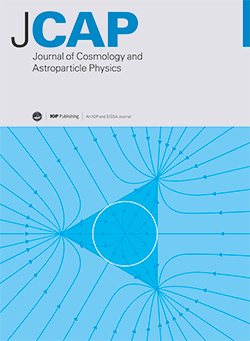Reproducing ΛCDM-like solutions in f(Q) gravity: a comprehensive study across all connection branches
IF 5.3
2区 物理与天体物理
Q1 ASTRONOMY & ASTROPHYSICS
Journal of Cosmology and Astroparticle Physics
Pub Date : 2025-05-28
DOI:10.1088/1475-7516/2025/05/098
引用次数: 0
Abstract
Given the remarkable success of the ΛCDM model in fitting various cosmological observations, a pertinent question in assessing the phenomenological viability of modified gravity theories is whether they can reproduce an exactly ΛCDM-like cosmic background evolution. In this paper, we address this question in the context of f(Q) gravity, where Q denotes the nonmetricity scalar. It is known that there are three possible symmetric teleparallel connection branches that respect the cosmological principles of spatial homogeneity, isotropy, and global spatial flatness. By enforcing a ΛCDM-like background evolution via the cosmographic condition j(z) = 1, where j is the jerk parameter, we reconstruct the ΛCDM-mimicking f(Q) theory for each of the three possible connection branches. For the first connection branch, also known as the “coincident gauge” in cosmology, we recover the previously known result that a theory of the form f(Q) = -2Λ + αQ + β√Q can exactly reproduce a ΛCDM-like cosmic evolution. Furthermore, we establish that the stability of the ΛCDM-like cosmic solution within this reconstructed f(Q), as well as the robustness of the reconstructed f(Q) form with respect to small errors in the astrophysical measurements of the jerk parameter. For the second connection branch, we analytically reconstruct the ΛCDM-mimicking f(Q) to be of the form f(Q) = -2Λ + αQ - βQ2. For the third connection branch, we could decouple the evolution equation for the dynamical connection function, which enabled us to perform a numerical reconstruction. Our analysis proves that, at least at the background level, it is possible to obtain ΛCDM-mimicking f(Q) models for all the three possible connection branches. These models effectively reduce to (STE)GR in the past while possessing a positive effective gravitational coupling throughout.在f(Q)重力中再现ΛCDM-like解:对所有连接分支的综合研究
鉴于ΛCDM模型在拟合各种宇宙学观测方面取得了显著的成功,评估修正引力理论现象学可行性的一个相关问题是,它们是否能够准确地再现ΛCDM-like宇宙背景演化。在本文中,我们在f(Q)重力的背景下讨论这个问题,其中Q表示非度量标量。已知有三种可能的对称远平行连接分支,它们尊重空间同质性、各向同性和全局空间平坦性的宇宙学原理。通过通过宇宙学条件j(z) = 1强制ΛCDM-like背景演化,其中j是jerk参数,我们为三个可能的连接分支中的每一个重建ΛCDM-mimicking f(Q)理论。对于第一个连接分支,也被称为宇宙学中的“重合规范”,我们恢复了先前已知的结果,即形式为f(Q) = -2Λ + αQ + β√Q的理论可以精确地再现ΛCDM-like宇宙演化。此外,我们建立了ΛCDM-like宇宙解在该重构f(Q)内的稳定性,以及重构f(Q)形式相对于jerk参数的天体物理测量中的小误差的鲁棒性。对于第二个连接分支,我们将ΛCDM-mimicking f(Q)解析重构为f(Q) = -2Λ + αQ - βQ2的形式。对于第三个连接分支,我们可以解耦动态连接函数的演化方程,从而使我们能够进行数值重建。我们的分析证明,至少在背景级别上,可以为所有三个可能的连接分支获得ΛCDM-mimicking f(Q)模型。这些模型在过去有效地降低到(STE)GR,同时始终具有正的有效引力耦合。
本文章由计算机程序翻译,如有差异,请以英文原文为准。
求助全文
约1分钟内获得全文
求助全文
来源期刊

Journal of Cosmology and Astroparticle Physics
地学天文-天文与天体物理
CiteScore
10.20
自引率
23.40%
发文量
632
审稿时长
1 months
期刊介绍:
Journal of Cosmology and Astroparticle Physics (JCAP) encompasses theoretical, observational and experimental areas as well as computation and simulation. The journal covers the latest developments in the theory of all fundamental interactions and their cosmological implications (e.g. M-theory and cosmology, brane cosmology). JCAP''s coverage also includes topics such as formation, dynamics and clustering of galaxies, pre-galactic star formation, x-ray astronomy, radio astronomy, gravitational lensing, active galactic nuclei, intergalactic and interstellar matter.
 求助内容:
求助内容: 应助结果提醒方式:
应助结果提醒方式:


